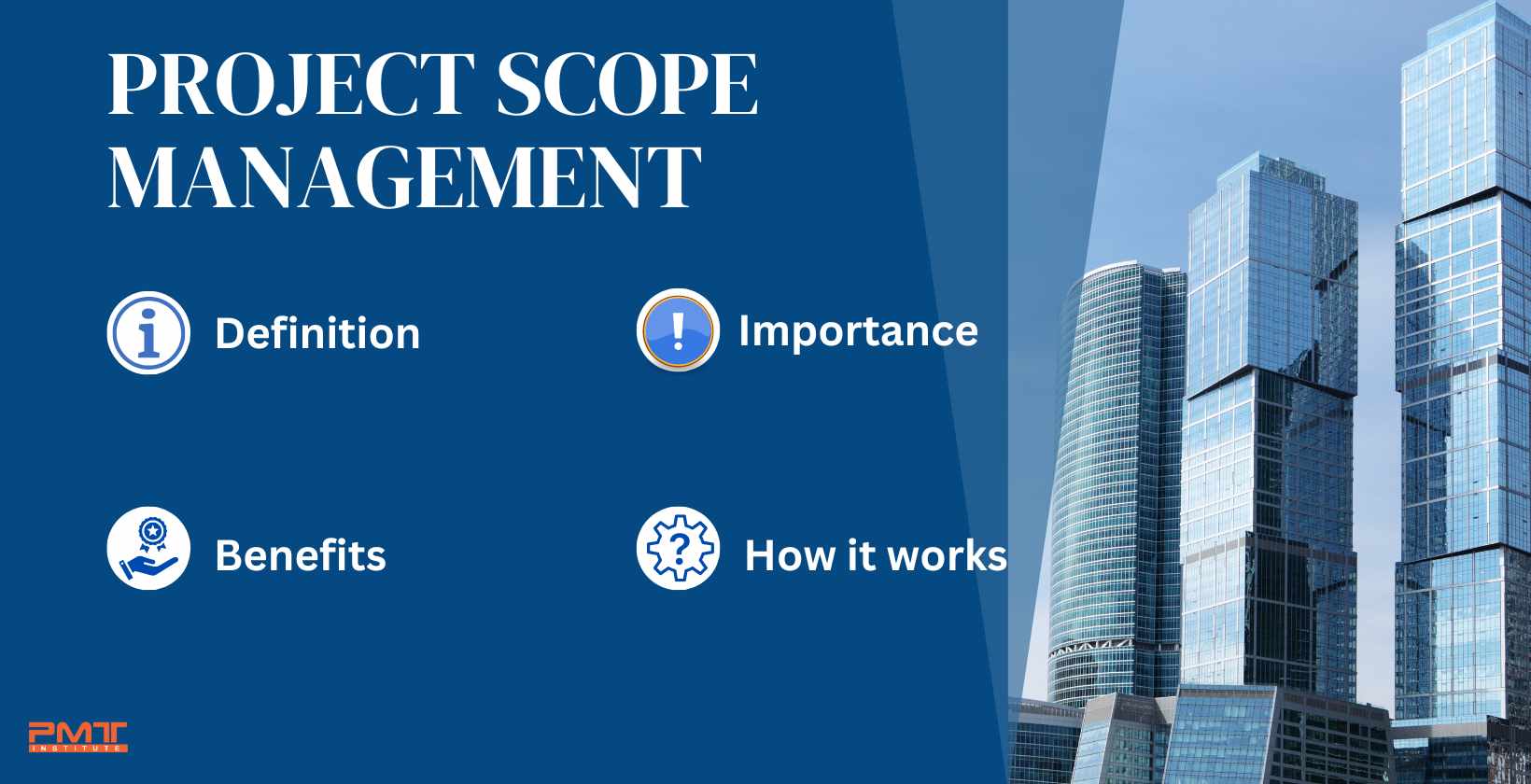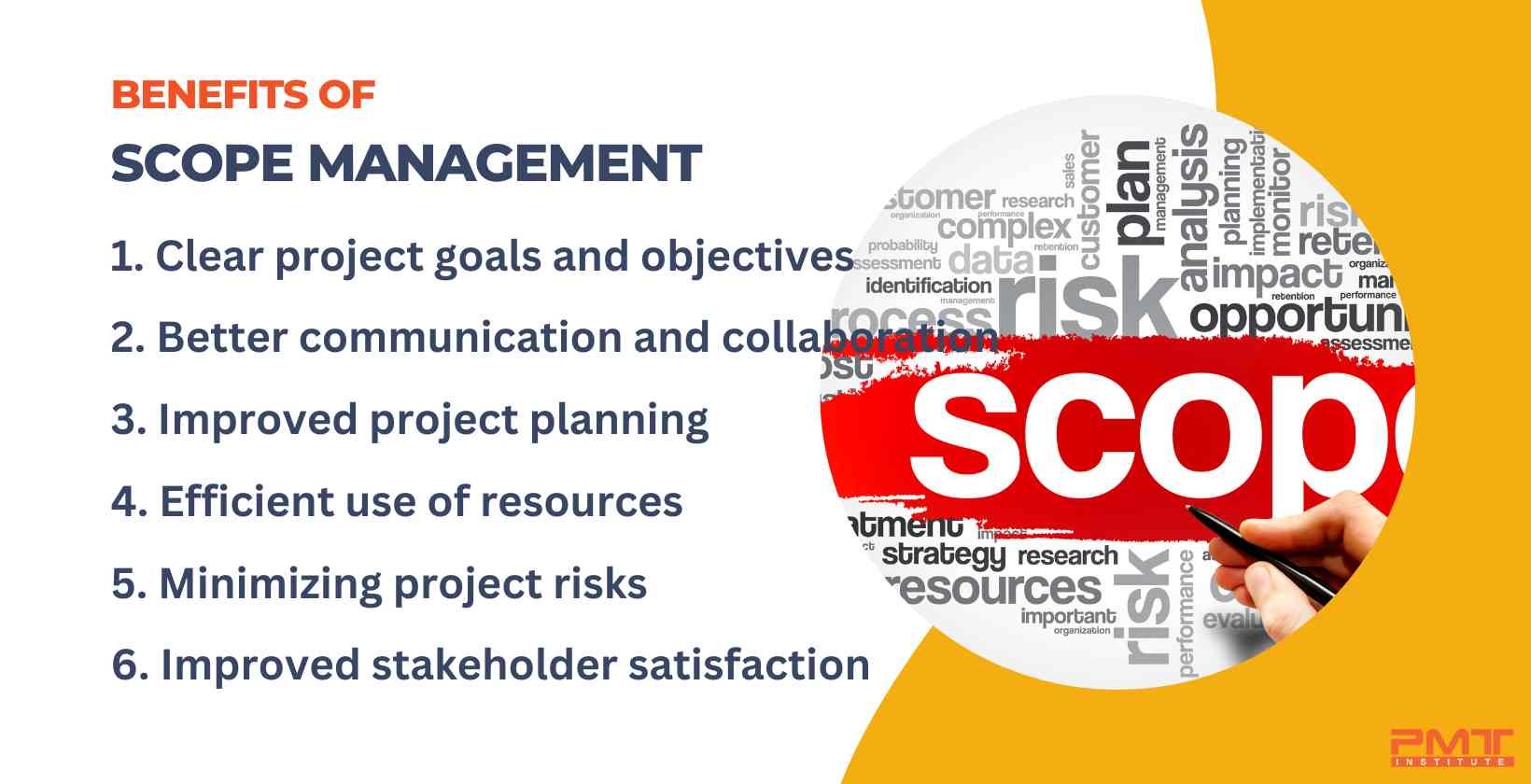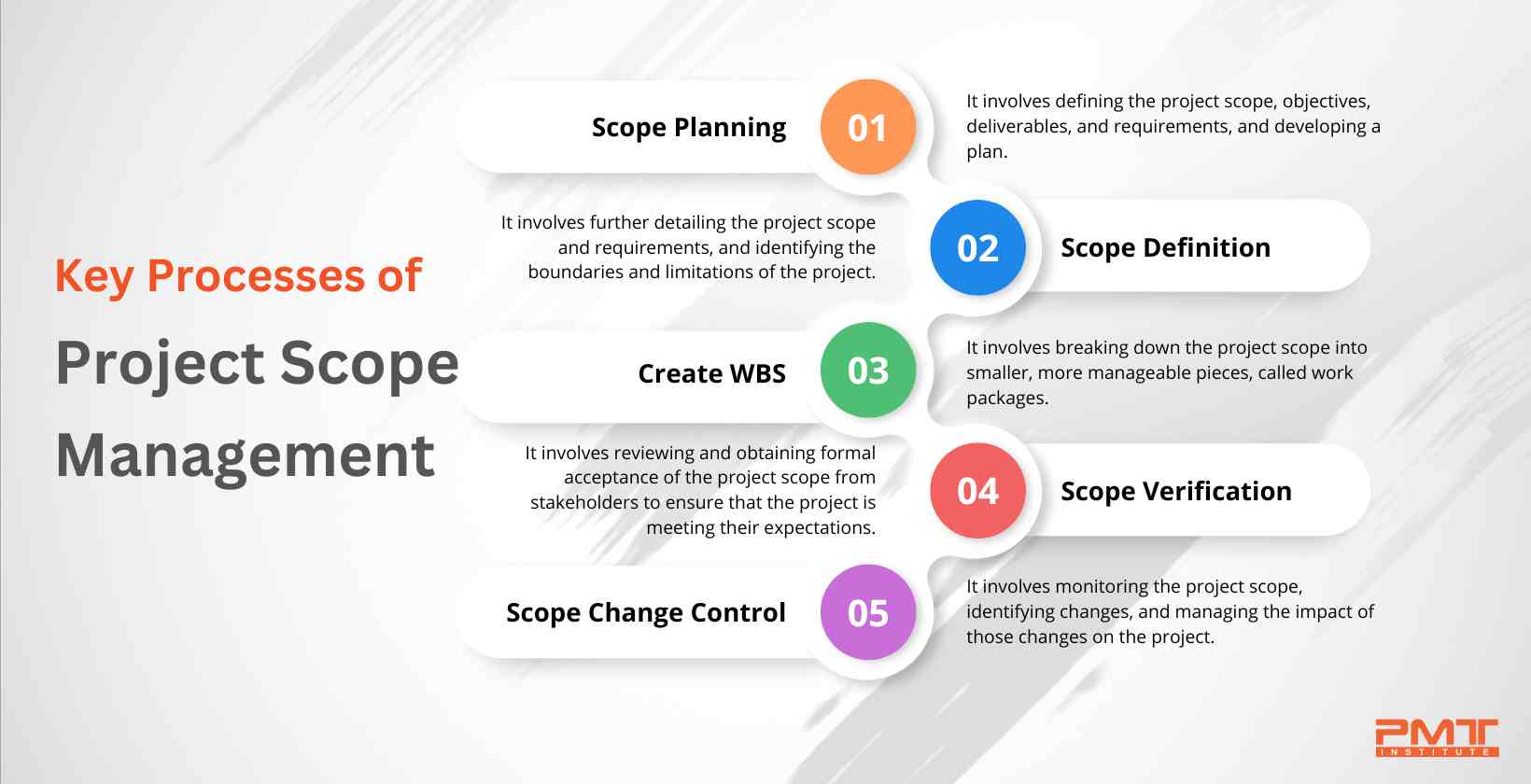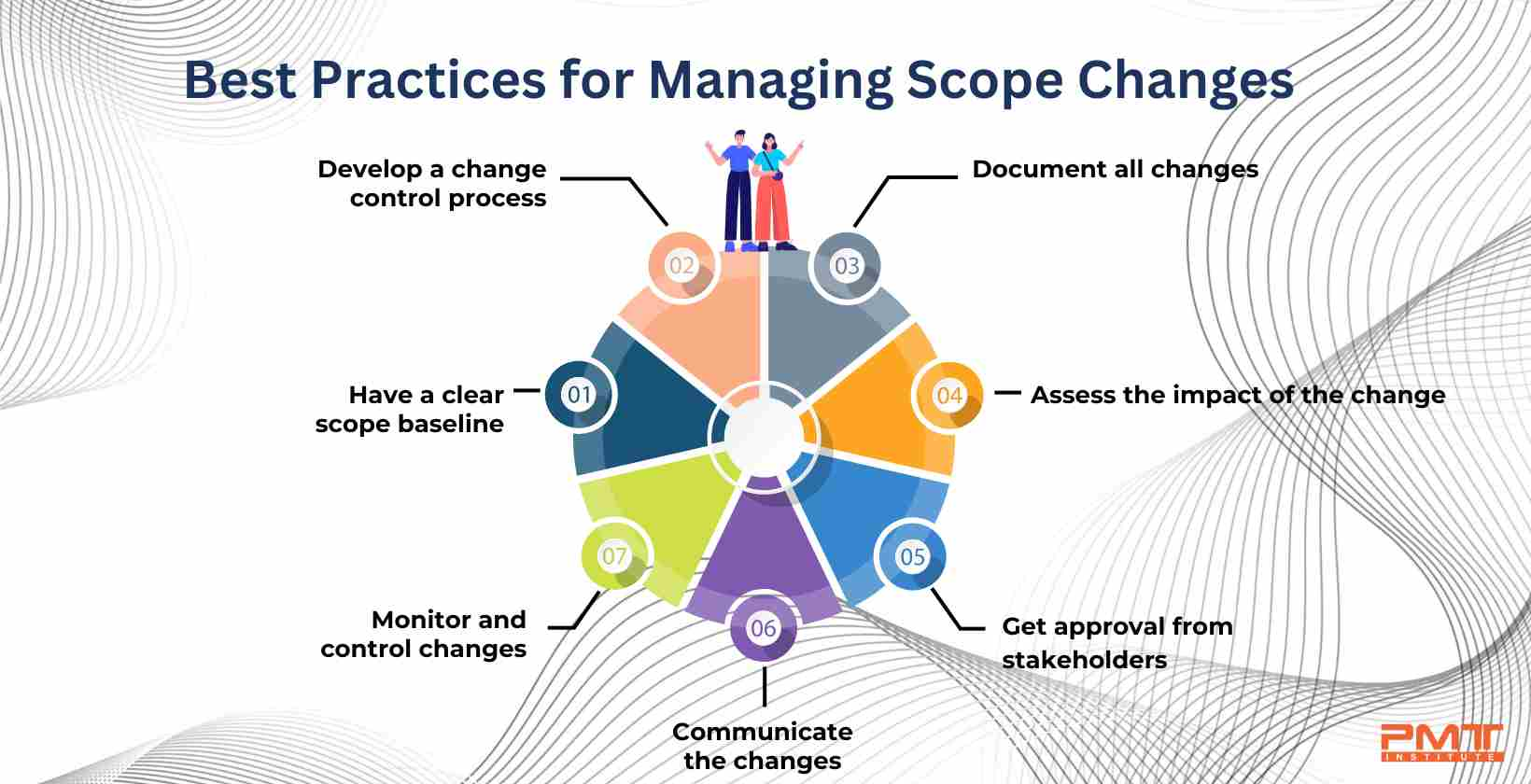Project Scope Management: Definition, Importance, Benefits, and How It Works
Published:
Updated:

Project Scope Management encompasses the process of defining, planning, monitoring, and regulating the scope of a project. It involves identifying the scope of the project, determining the deliverables, and establishing the parameters within which the project is slated to be completed. A Project Scope Management's value rests in its facilitation of efficient management of project time, money, and resources. Scope creep occurs when a project's scope grows uncontrollably without adequate supervision, often resulting in missed deadlines, increased costs, and lower quality.
Planning, defining, verifying, and controlling the scope of a project are all essential parts of effective project scope management. The project team creates a scope management strategy after determining the project's boundaries. The team further specifies the project's scope, deliverables, and objectives during the scope definition process. The other two processes, scope verification, and scope change control, work together to guarantee that the project's final products are exactly what was promised.
The benefits of Project Scope Management consist of enhanced project planning, higher productivity, and clearer lines of communication among all parties involved. Project managers head off problems before they arise by keeping an eye on the big picture and keeping track of all the moving parts.
Table of Contents
Misunderstandings among project team members, stakeholders, and clients are mitigated by transparent communication about project scope and objectives. A good example of such is in a software development project, where the scope covers everything from concept creation through final deployment. Hardware acquisition and infrastructure setup are outside the scope and are handled by a different group or provider.
What is Project Scope Management?
Project Scope Management is responsible for outlining, scheduling, tracking, and closing the tasks that must be completed in order to accomplish the project's stated goals and objectives. It includes managing the requirements, deliverables, tasks, deadlines, and limitations of a project and entails tracking and responding to changes as they occur. Managing the scope of a project is essential to its success since it helps keep it within its parameters, satisfies stakeholders' needs, and finishes on schedule and on budget.
Scope management for a project is effective as it involves breaking the project down into smaller, more manageable chunks, defining the scope of work for each chunk, creating a plan for managing scope, reviewing progress against the plan, and making adjustments as needed to keep the project on track.
What is the Importance of Project Scope Management?
The importance of Project Scope Management is widely recognized in the project management community. It is a fundamental process that helps project managers to define the project objectives, determine the scope of work, and set boundaries for the project.
A study by the Project Management Institute (PMI) found that organizations with mature project management practices had a higher success rate in meeting project objectives than those with less mature practices. Moreover, organizations that utilized a formal Project Scope Management process reported a higher percentage of completed projects within budget and on time.
Another study conducted by the Standish Group found that one of the primary reasons for project failure is poor scope management. The study revealed that more than half of all project failures are due to scope-related issues, such as incomplete or poorly defined requirements, inadequate project planning, and failure to control scope creep.
Additionally, a study by the Construction Industry Institute (CII) found that effective Project Scope Management is one of the most important factors contributing to project success. The study found that successful projects had a well-defined scope, a clear scope management plan, and a system for managing changes to the project scope.
Effective Project Scope Management helps project managers to identify potential risks and address them before they become issues. Clearly defining the scope of the project and documenting it in a scope management plan help project managers ensure that all stakeholders have a clear understanding of the project objectives, deliverables, and boundaries.
Research has consistently shown that effective Project Scope Management is critical for project success. Properly defining the project scope and managing changes to it help prevent scope creep, identify and mitigate risks, support resource management, and promote better communication and stakeholder engagement.
How Does Project Scope Management Work?
Project Scope Management involves a number of processes that help to ensure that a project remains within its defined boundaries and satisfies stakeholder requirements. Definition of the project's scope, objectives, deliverables, and requirements is the first step in Scope Planning. It involves creating a strategy for managing the project's scope throughout the project lifecycle. The scope management plan describes how alterations to the project's scope are managed and the procedures for monitoring and controlling the project's scope.
The second process is Scope Definition, which entails elaborating on the project's objectives and scope. It involves designating the specific tasks, activities, and deliverables necessary to achieve the project's goals, as well as the project's boundaries and constraints. Scope Verification is the process of reviewing and acquiring formal acceptance of the project's scope from stakeholders to ensure that the project is meeting their expectations and requirements. Such a procedure ensures that all project participants are on the same page and that the project meets stakeholder expectations.
Scope Change Control concludes with the surveillance of the project's scope, identification of changes, and management of the changes' impact. It entails evaluating the impact of changes on the project's timeline, budget, and resources, and obtaining approval from stakeholders prior to implementing changes. The process prevents scope creep and ensures that any modifications to the project's scope are appropriately approved and managed.
Effectively managing the project's scope enables project managers to ensure that the project remains within its defined boundaries, meets the requirements and expectations of stakeholders, and meets its deadlines and budget constraints.
What are the Benefits of Project Scope Management?
Effective Project Scope Management provides several benefits, including:
-
Clear project goals and objectives: The project's success depends on the team's ability to clearly define the project's scope and objectives. Team members are better able to grasp what is needed to complete the project successfully, and the project's efforts are better able to mesh with the larger business vision. Team members are less likely to disagree if they have a shared knowledge of the project's goals.
-
Better communication and collaboration: Having a defined project scope helps to ensure that all parties involved in the project have a common knowledge of its goals and expectations. Good communication and teamwork are essential to ensure the project continues on track and any challenges are resolved quickly and efficiently.
-
Improved project planning: A well-planned project, with clearly defined tasks and deliverables, is going to be completed on time and within budget thanks to careful Scope Management. It lessens the likelihood of costly delays or overruns and keeps the project on track. Early detection and resolution of problems are facilitated by thorough planning.
-
Efficient use of resources: Project managers are better able to determine what people, machines, and supplies are going to be required to carry out a project if its scope and requirements are clearly defined. Managing project scope effectively allows project managers to avoid unnecessary work, which helps reduce costs and improve project efficiency.
-
Minimizing project risks: The sooner risks and issues are identified in the project lifecycle, the sooner they are able to be mitigated and contingency plans are developed. Overall project outcomes are enhanced as risks are mitigated and issues are avoided.
-
Improved stakeholder satisfaction: Project managers are able to guarantee that their work is going to satisfy stakeholders if they handle scope management seriously. Stakeholders are more likely to be pleased with the final product when they see that their concerns were taken into account and handled.

Effective Project Scope Management is critical for project success. It helps to ensure that the project stays on track and meets stakeholder expectations, while promoting effective communication and collaboration, improving project planning and resource allocation, minimizing risks, and improving stakeholder satisfaction at the same time.
Who is in charge of determining the Scope and Management of the Project?
The project manager is responsible for setting the project's goals and overseeing its execution. Project managers must oversee the scope of the project at all times, which involves adhering to the project management process detailed in the field of Project Scope Management. The first step in managing the project's scope is the creation of a Scope Management Plan by the project manager. A project's scope, objectives, and needs, as well as the mechanisms for monitoring and controlling those factors, are all laid out in such a plan.
The project manager then refines the scope by detailing the steps and deliverables that must be completed in order to reach the project's goals. The assumptions made during the planning phase, as well as the project's limits and scope, are highlighted as well. The project manager formally accepts the project scope after evaluating it with everyone involved to make sure the project is living up to everyone's expectations and needs.
The project manager's role is to keep an eye on the project's scope, keep track of any changes, and deal with the fallout from any alterations. Changes must be evaluated for their potential effect on the project's timeline, money, and resources, and stakeholders must be consulted and approved before any action is taken. The project manager's responsibility is to keep the project on schedule and in line with stakeholder expectations through careful management of the project's scope.
What is the Role of Stakeholders in Project Scope Management?
Stakeholders play a vital role in Project Scope Management. Stakeholders are individuals or groups that have a vested interest in the project and its outcomes. The project manager works closely with stakeholders throughout the project lifecycle to ensure that the project scope is well-defined and aligned with stakeholder needs.
Stakeholders provide input on the project scope, objectives, and requirements, helping to ensure that they are well-defined and meet their expectations. They review and provide formal acceptance of the project scope, ensuring that the project is meeting their expectations and requirements.
Additionally, stakeholders are able to identify changes that need to be made to the project scope and must approve any changes before they are implemented. Effective stakeholder management is crucial for the success of project scope management. The project manager must engage with stakeholders throughout the project lifecycle to make sure that their needs are understood, and that they are informed about the changes to the project scope. Doing so helps ensure that the project stays on track and meets stakeholder expectations. Working closely with stakeholders allows project managers to achieve a successful project outcome.
What are the Key Processes of Project Scope Management?
The key processes of project scope management are:
-
Scope Planning: It involves defining the project scope, objectives, deliverables, and requirements, and developing a plan for how the project scope is managed throughout the project lifecycle. The scope management plan outlines how changes to the project scope are handled and the processes for monitoring and controlling the project scope.
-
Scope Definition: It involves further detailing the project scope and requirements, and identifying the boundaries and limitations of the project. Scope Definition includes identifying the specific tasks, activities, and deliverables required to achieve the project objectives.
-
Create WBS: It involves breaking down the project scope into smaller, more manageable pieces, called work packages. The work packages are then organized into a hierarchical structure called the Work Breakdown Structure (WBS).
-
Scope Verification: It involves reviewing and obtaining formal acceptance of the project scope from stakeholders to ensure that the project is meeting their expectations and requirements.
-
Scope Change Control: It involves monitoring the project scope, identifying changes, and managing the impact of those changes on the project. Scope Change Control includes assessing the impact of changes on the project schedule, budget, and resources and obtaining approval from stakeholders before implementing changes.

These processes are interrelated and built upon each other to ensure that the project scope is well-defined, managed, and controlled throughout the project lifecycle. Following these processes allows the project team to ensure that the project meets stakeholder expectations, stays on track, and is completed on time and within budget.
How Do Project Managers Communicate the Project Scope Effectively?
Project managers use a variety of strategies to communicate the project scope effectively. Developing a scope statement is a crucial step in any successful plan. A project's scope statement is a written description of the project's intended outcomes, activities, and deliverables. The scope declaration needs to be written in simple, straightforward language. To make sure everyone is on the same page, it needs to be reviewed and approved by everyone involved in the project before work begins.
Making a WBS is a useful method as well. A Work Breakdown Structure (WBS) is a graphical depiction of the project's scope that helps break it down into more manageable chunks. The Work Breakdown Structure (WBS) explains the organization of the project and how each part fits into the bigger picture. Additionally, holding regular meetings with stakeholders is crucial for conveying the project's scope clearly. These meetings provide the project manager an opportunity to update stakeholders on the status of the project, address any concerns or issues, and keep everyone involved in the loop as the project develops.
One of the most effective methods of keeping stakeholders in the loop is by regularly updating them on progress. These reports provide an overview of the project's goals, milestones, and any subsequent adjustments. They clarify for those involved the state of the project and any alterations that have been made. Communicating the scope of a project effectively is additionally enhanced by the use of visuals like charts, graphs, and diagrams. These tools make it much simpler to comprehend otherwise difficult material.
All in all, it's crucial for project success to have clear and consistent communication about the scope of the work being done. Project managers have the ability to increase the likelihood that their projects are going to be completed on time, under budget, and to the satisfaction of all parties involved by emphasizing the importance of clear communication and the use of visual aids.
How Do Project Managers Ensure the Project Scope is Aligned with the Objectives?
It is essential for a project's success that the scope of the project matches its goals. Managers of projects need to have a firm grasp on the project's intended outcomes, which they must then convey clearly to all parties involved. Doing so makes it more likely that everyone involved in the project has the same expectations.
Project stakeholders must help craft the project scope statement to ensure it adequately captures the scope of work to be accomplished. To make the project more manageable, a work breakdown structure (WBS) is developed. It is a graphical depiction of the entire project's scope.
The project manager is responsible for keeping the project's scope up to date and in line with the project's goals at all times. It is important to consider how a shift in the project's scope affects the end goal and revise the project plan accordingly.
Project managers must establish and convey to all stakeholders precise methods for scope management in order to monitor and regulate the project's scope. It includes articulating a process for handling changes to the project's scope and making sure everyone involved understands how such alterations impact the project's schedule, budget, and resources.
Project success and stakeholder satisfaction are ensured if managers follow these measures to guarantee that the project scope is in line with the project objectives. Achieving such alignment is essential for successfully completing a project on time, within budget, and to the satisfaction of all stakeholders.
How Do Project Managers Identify and Manage Scope Creep in Projects?
The term "scope creep" is used to describe when a project's scope grows beyond its initial goals and objectives without enough planning or planning permission. Significant time and money waste, as well as compromised quality, lead to such issues. The project manager is largely responsible for controlling scope creep. They are in charge of evaluating and managing any modifications to the project's scope to ensure that it remains aligned with the project's goals and objectives.
Managers of such projects must employ a variety of tactics for dealing with scope creep. The first step in each project is to create a detailed scope statement that specifies the project's aims, methods, outputs, and schedule. Additionally, project managers must set up a rigorous change control procedure to monitor and handle any and all alterations to the project's original scope. The sponsor or stakeholders have to review and approve any proposed changes to the project's scope before proceeding with a project.
Project managers need to make sure the project scope is still in line with the original project objectives on a frequent basis as well. The time, money, and manpower that are required to implement a scope modification must be considered. Project managers have to inform all parties involved of any changes and how they are likely to affect the project's schedule, money, and resources. Moreover, such measures aid in controlling stakeholder expectations and preventing unnecessary expansion of the project's scope.
Managers are obliged to keep an eye on the project's development for signs of scope creep. The effects on the project's schedule, money, and resources must be documented and assessed after any deviations have occurred. The project manager needs to take corrective action to keep the project scope under control if necessary. Some examples include making adjustments to the project's scope, schedule, or priority. Scope creep has a significant negative influence on a project's scheduling, budget, and resources if not properly identified and managed.
What Are the Consequences of Poor Project Scope Management?
Poor project scope management leads to various consequences, including:
-
Project delays: Poor scope management results in changes to the project scope that delay project completion. The project is likely to suffer from rework, as the team has to redo work that was not included in the original scope.
-
Increased project costs: Changes to the project scope leads to increased project costs, as the team requires additional resources to complete the project. These additional costs have not been accounted for in the project budget, leading to budget overruns.
-
Poor quality deliverables: A project scope that is not clearly defined or changes frequently leads to poor quality deliverables. It's because the team does not have a clear understanding of what is expected of them, or they rush to complete the project to meet changing deadlines.
-
Dissatisfied stakeholders: Poor project scope management results in dissatisfied stakeholders, as the project failed to meet their expectations or requirements. Such consequences cause strained relationships and damage to the project manager's reputation.
-
Reduced team morale: Frequent changes to the project scope result in confusion and frustration among the project team and reduces morale and productivity.
Project scope management must be given priority to mitigate these consequences. Project managers must ensure that the project scope is clearly defined, communicated, and understood by all stakeholders to mitigate these consequences.
Such is achieved by developing a scope management plan, setting clear project objectives and deliverables, establishing a formal change control process, regularly reviewing project scope, and communicating any changes to stakeholders. Additionally, regular project status updates and stakeholder engagement helps ensure that all stakeholders are aligned with project objectives and expectations.
What Are the Best Practices for Managing Project Scope Changes?
Managing project scope changes is a challenging task for any project manager. Listed below are some best practices that help:
-
Have a clear scope baseline: Project managers must ensure that they have a clear and agreed-upon scope baseline at the start of the project, including the project objectives, deliverables, timelines, and budget.
-
Develop a change control process: Develop a formal change control process that outlines how scope changes are identified, evaluated, and approved or rejected. The process must define how changes are communicated to the project team and stakeholders.
-
Document all changes: Document all scope changes, including the reason for the change, the impact on the project timeline, budget, and deliverables, and the approval process.
-
Assess the impact of the change: Evaluate the impact of the change on the project's objectives, timeline, budget, and resources. Identify any risks and dependencies that are likely affected by the change.
-
Get approval from stakeholders: Obtain approval from all stakeholders, including the project sponsor and the project team, before implementing any scope changes. Doing so helps ensure that everyone is aware of the changes and their impact.
-
Communicate the changes: Communicate any scope changes to the project team, stakeholders, and any other relevant parties, which include the impact of the change and any revised timelines or budget.
-
Monitor and control changes: Monitor and control any scope changes to ensure that they do not have a negative impact on the project's objectives, timeline, budget, or quality.

Following these practices aids project managers in effectively managing scope changes and ensuring that the project stays on track.
Is the Project Scope Management Part of the Project Planning Process?
Yes, project scope management is an integral aspect of any successful project strategy. The Project Management Institute (PMI) includes it as a core competency in their Project Management Body of Knowledge (PMBOK) Guide. The project's goals, deliverables, and requirements, as well as a plan for how the project's scope is maintained throughout the project's lifecycle, must all be defined as part of the scope management process.
Common components of a scope management plan are the scope statement, scope baseline, and methods for managing changes to the scope. A well-defined scope management strategy helps project managers keep their projects on schedule and on target.
Do the Project Managers Manage Project Scope Management?
Yes, project managers are responsible for managing project scope management. It is one of the primary responsibilities of a project manager to ensure that the project stays within the defined scope, meets the objectives, and delivers the expected outcomes. Project managers must ensure that the project's scope is well-defined and that it aligns with the stakeholders' expectations. They must manage any changes to the project's scope to prevent scope creep and ensure that any changes are evaluated and approved before implementation as well.
Project managers must have a clear understanding of the project's scope, including its objectives, deliverables, and requirements, and develop a scope management plan that outlines how the scope is managed throughout the project's lifecycle. They have to monitor and control the scope throughout the project to ensure that it stays on track and aligns with the project's objectives. Therefore, it is the project manager's responsibility to effectively manage the project scope management.
Is Project Scope Management Necessary for the Project?
Yes, project scope management is essential to a project's success. It's a useful tool for making sure the project stays on track and accomplishes its goals. A project's scope is likely to expand beyond its initial goals, causing delays, budget overruns, and dissatisfied stakeholders without proper scope management.
Project managers ensure that all team members are on the same page with regard to the project's intended outcomes and deliverables through effective scope management. Doing so improves the project's chances of success by bringing it in line with the hopes of those who are going to be affected by it.
Moreover, good scope management aids in the proactive management of project risks by identifying and controlling prospective modifications to the project's scope. The framework ensures that changes are assessed for their potential effect on the project's schedule, money, and goals, and that approval is granted only after all relevant factors have been considered. Therefore, a clear framework for defining, managing, and regulating the project's scope throughout its lifecycle is required in order to guarantee the project's success.



